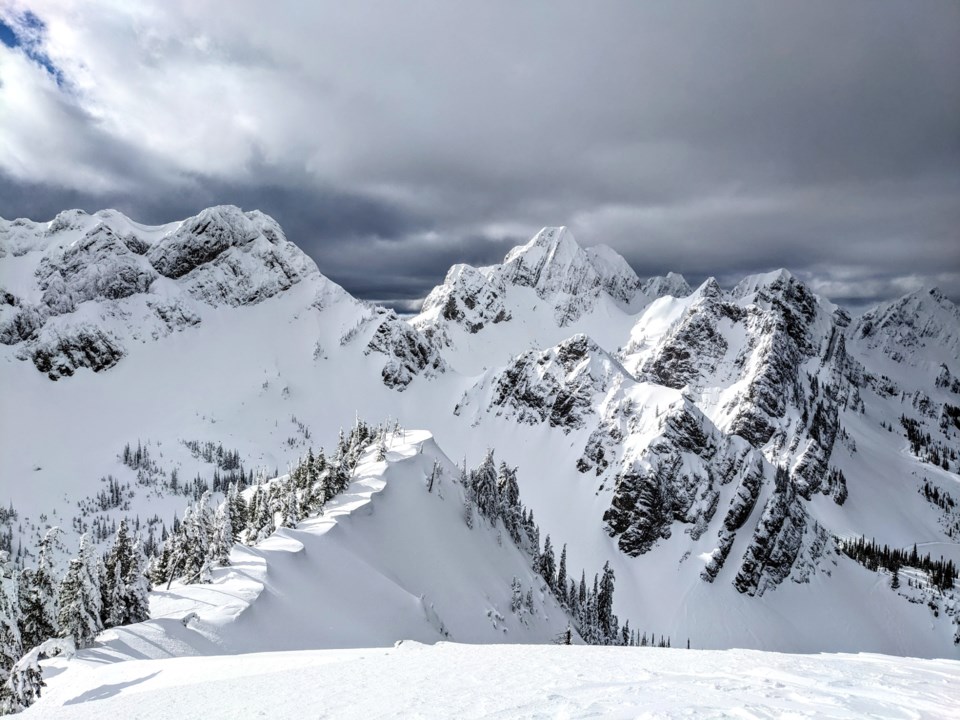Well, it took until the final days of February, but the season came back swinging.
One of my favourite ski-town jokes I’ve heard over the years is: “It’s always snowing next week.” Meaning, when locals are snow-deprived, there always seems to be some carrot dangling in the distance of the long-range forecast. The 2023-24 season has been a series of over-forecasted, underperforming storms. Until now.
Skiing last weekend on my favourite mountain (Blackcomb, of course), I finally felt like it was ready. I could ski right over powder-stacked rollovers and not worry (nearly as much) about what was on the other side. Chutes and little alleyways in the trees were overflowing with pow, with plenty of the soft stuff to slow you down as you exit at Mach-chicken speed. By the time this publishes, the alpine will have opened, with skiers and riders able to let loose and revel in the now mid-winter conditions. Get after it, Whistler—you earned this.
Back in February, before these Herculean storms arrived, I was on a road trip to B.C.’s Interior (Pique, March 1, “Exploring the Interior, Part 1—Kicking Horse”). The second half of the trip took me and our merry F-150 full of skiers to Fernie. Our crew had entered the booking lottery for Interior backcountry huts for the penultimate week in February, and the one that came up was the Thunder Meadows Hut. Having had a successful first half of the trip with a mix of resort and backcountry skiing, we applied the same formula for Fernie.
I’ve been looking to check Fernie Alpine Resort off my bucket list for years. A big part of that is the sheer distance from the coast. The drive from Whistler is just shy of 12 hours, so if you’re heading out that far, you’ll probably want to add some skiing stops along the way. Fernie is just over three hours from Calgary, and competes with Kicking Horse and the SkiBig3 Resorts in Banff within that three-hour driving radius from the closest major city.
Fernie Alpine Resort holds its own against all the aforementioned resorts, both in vertical (1,082 metres) and in terrain (more than 50-per-cent advanced/expert, with four per cent labelled as “Extreme”). The resort links five main bowls: Siberia, Timber, Currie, Lizard and Cedar. Each bowl has steep tree skiing with a mix of gladed and non-gladed runs, with the best skiing being accessed via traverses along the ridges. That’s something to note when skiing in Fernie; you’ll be doing A LOT of traversing to get to your lines, and skating along flat cat tracks to get back to the lift. Snowboarders were fewer in proportion than I’ve seen at other resorts on the Powder Highway.
The crowning jewel of Fernie Alpine Resort is Polar Peak (2,134m elevation), a wall riddled with steep faces, chutes and headwalls, and flanked by permanently closed areas that are simply too steep and dangerous to ski. This is the terrain that has put Fernie on the map with ski-film segments and freeski competitions. The catch is, it needs ideal conditions to open. Fernie has one of the highest explosives budgets for avalanche control in B.C., and a lot of those explosives are used to control the terrain on Polar Peak. If it’s storming, gusting, or otherwise considered not safe to ski (as it was when we skied there), you’ll have to come back to sample it another day.
After a full day of hunting wind-accumulated pow in the treed ridges, we retire to The Griz Bar, Fernie’s most beloved après venue where live country music blares with a full house of celebrating skiers. The charm of Fernie’s small-town culture is everywhere around us.
To cap the trip, the next day we slog three days’ worth of gear and provisions up to the Thunder Meadows Hut, a couple of backcountry bowls northwest of the resort. An under-forecasted overnight storm drops about 20 centimetres of fresh, and we spend the next two days working the ridges and taking turns dropping into chutes and fanning out into treeline pow fields. Since Thunder Meadows is a buyout-only hut, our crew of four are the only skiers in the entire area. We don’t see a soul until the afternoon of our checkout, where an exhausted trio of snowboarders arrive with their overnight gear and many cans of beer.
The next day we pile back into the F-150 for the cross-province return journey, staying ahead of the incoming storm that blankets the Interior. Exhausted after skiing and touring eight of the last nine days on the road, we brace for Whistler’s triumphant return to real winter. I think we’re ready.
Vince Shuley vehemently believes March is for skiing. For questions, comments or suggestions for The Outsider, email [email protected] or Instagram @whis_vince.




